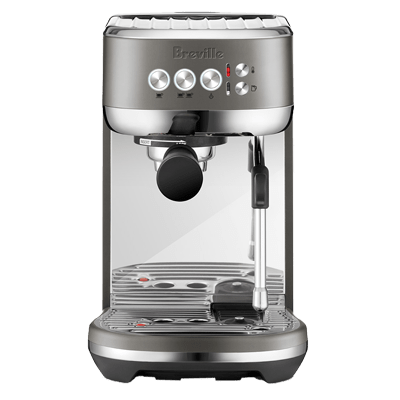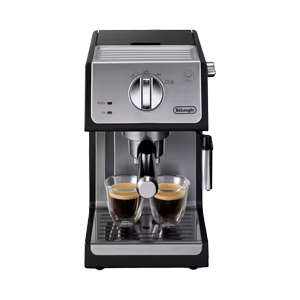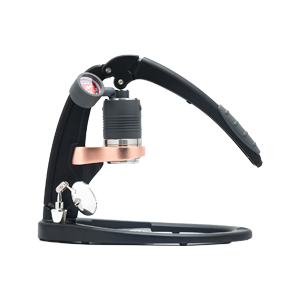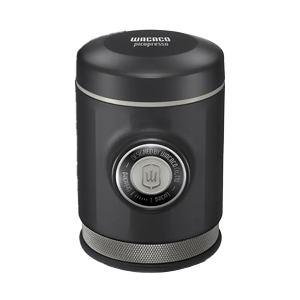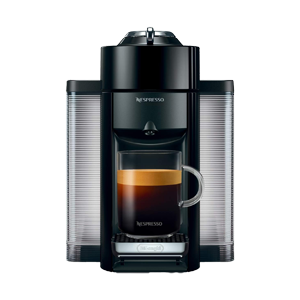Finding a high-quality espresso machine under $300 doesn’t mean sacrificing performance. In this 2025 guide, we review machines with powerful pressure systems, built-in milk frothers, and solid build quality and all tested for real home use. Get barista-level espresso without the premium price tag.
Espresso machines in this price range are often a smart value purchase, striking a solid balance between performance and affordability. However, it’s worth noting that even the best machines under $300 can fall short when it comes to capturing the finer nuances in an espresso shot.
It’s mainly due to limited temperature control and simpler internal components. That’s why, no matter which espresso machine you choose, pairing it with a high-quality standalone grinder is crucial. A good grinder ensures a consistent grind size, which is key to unlocking better flavor, aroma, and crema in every cup.
This compact machine, measuring just 12 inches tall and 7 inches wide, delivers a café-quality espresso experience without dominating your countertop.
One of its standout features is the lightning-fast heat-up time in just three seconds to reach optimal brewing temperature. This is a game-changer for busy mornings when every minute counts. Despite its small footprint, the Bambino includes a 1.4L water tank, which lasts several days with moderate use.
The user interface is refreshingly simple, with just four buttons controlling shot volume, steam, and hot water. While the portafilter is primarily plastic and can be tricky to secure in the group head, it’s a reasonable compromise for the price and size.
The espresso quality surprised me in the best way. Using the double-shot basket, you will be able to dial in 18g of coffee for consistently rich, crema-topped shots. The ability to customize shot volume manually is a nice bonus for those wanting to fine-tune their brew.
The steam wand, though short and slightly awkward to position, is powerful enough to create silky, café-style microfoam ideal for latte art. It does take longer than higher-end machines to steam milk, and cleaning the wand requires a bit of care, but the end result is worth it.
If I had to nitpick, the hot water feature isn’t very practical, and the portafilter could benefit from a sturdier design. However, these are minor issues in an otherwise impressive entry-level espresso machine.
Overall, the Breville Bambino offers outstanding value for those new to espresso or seeking a compact, reliable machine that doesn’t sacrifice performance. It’s a great starting point for anyone looking to elevate their home coffee setup.
The DeLonghi Dedica Maestro Plus is a well-designed machine that strikes a great balance between beginner-friendliness and room for espresso exploration. Out of the box, it’s sleek and compact with a premium feel, especially with the upgraded stainless steel portafilter and larger 1.6L water tank.
In basic mode, the machine is incredibly easy to use. If you use pre-ground coffee with the pressurized basket you will be pleasantly surprised by the espresso quality it’s smooth, with a decent layer of crema. It’s a forgiving setup, perfect for beginners not yet ready to invest in a grinder. The auto steam wand is another win: it steams milk at the push of a button and produces consistent results. It’s not perfect and sometimes a bit too airy, but it’s a lifesaver for quick cappuccinos.
Advanced mode is where the Maestro Plus really shines. We paired it with a bottomless portafilter, precision basket, and our Eureka Libra grinder, and the results were a major step up. Shots were more balanced and flavorful, and manual milk frothing produced silky microfoam perfect for latte art. The machine holds its temperature surprisingly well for a thermoblock system, though it’s not quite as consistent as a dual boiler setup.
The main gripe is the lack of a hot water spout therefore no easy Americanos here. But overall, you’ll love how the Maestro Plus supports growth. It’s simple enough for casual use but capable enough for a budding home barista. For a budget price, it’s a compelling upgrade over the older Dedica models, especially if you value milk steaming and programmability.
Highly recommended if you’re serious about home espresso without going full prosumer.
The Delonghi ECP3420 has been a great entry point into making café-style coffee at home without spending a fortune. What initially drew me in was the fact that it’s the best-selling espresso machine on Amazon and after using it in our testing here is what we think.
The machine is compact and doesn’t take up much counter space, which is perfect for a small kitchen. It’s incredibly easy to use in its basic mode, just load some pre-ground coffee into the pressurized basket, turn the knob, and you’re good to go. The pressurized portafilter helps compensate for inconsistencies in grind size, so even store-bought coffee can produce a decent shot with a nice crema.
However, where this machine really shines is in advanced mode. If upgraded to a bottomless portafilter, removed the panarello steam wand cover, and invested in a proper grinder and WDT tool. With these upgrades, the machine is capable of pulling surprisingly high-quality shots. The boiler heats up quickly, and the actively heated brew group makes a noticeable difference in extraction temperature and taste.
Milk frothing is adequate in basic mode, but with the panarello removed, it can get that silky microfoam needed for latte art. It takes a bit of practice, but it’s worth it.
The build is mostly plastic, but it feels sturdy for the price. Cleaning is simple, and the included accessories are decent. We do wish it had better clearance for a scale, but that’s manageable with a bottomless portafilter.
Overall, the ECP3420 offers amazing value for beginners and enthusiasts alike. It’s a budget machine that punches well above its weight, especially if you’re willing to make a few affordable modifications.
If you’re considering the Flair Pro 3, you’re probably someone who loves the ritual and craft of espresso. After using it extensively,in our testing: it’s not for everyone, but if it is for you, you’re going to love it.
The Pro 3 builds on the Pro 2 with thoughtful upgrades that refine the experience. The magnetic shot mirror is a big win therefore finally, you can monitor your shot without twisting yourself around. The preheat funnel makes warming the brew chamber easier and more efficient, addressing one of the biggest pain points of manual espresso. The new drip tray is heavier and more stable, and the larger, better-organized carrying case is a welcome change. Build quality overall feels more polished and professional.
That said, the core espresso performance is still about the same as the Pro 2, great shots with full manual control. You control pressure, timing, and yield in real time, which makes for a more involved, educational experience. It’s especially rewarding if you’re using light roasts or experimenting with technique.
But this is not a machine for convenience. It takes time, cleanup is messy, and the process can be tedious. You’ll need to preheat (despite the “no-preheat” claim), and making back-to-back shots is a hassle unless you invest in spare parts.
Still, if you’re passionate about espresso and want a hands-on learning tool that delivers quality shots and helps you understand the fundamentals, the Flair Pro 3 is arguably the best manual machine in its class. It’s ideal for those who value control, craft, and a deep connection with the process.
If you’re looking for a hands-on, satisfying way to make espresso at home, the ROK espresso maker could be your next favorite ritual. Right out of the box, you’ll find it compact, well-built, and intuitive to use and with a clever design that delivers high pressure using relatively little force.
The included portafilter spouts clip on easily, though they do feel a bit fragile, and you may find yourself skipping them entirely if you mostly brew doubles. For added flair (and visibility), there’s also the option of a naked portafilter.
Heat management is the biggest challenge here. Since the ROK doesn’t have a heating element, you’ll need to preheat everything that is portafilter and body included, before pulling a shot. A quick trick is to run a blank shot first, soaking the unit with boiling water to retain maximum temperature. If you’re used to conventional espresso machines, the right-to-center portafilter lock might throw you off the first time.
You’ll appreciate the control this device offers: from pre-infusion to pressure, you’re in charge. Using freshly boiled water and allowing a 15-second pre-infusion can help dial in your extraction. The puck is easy to knock out and especially if you give one last press after the shot’s done.
The included tamper is hefty but slightly undersized, and the dosing cup can be a bit messy. Still, paired with a quality hand grinder, the ROK performs beautifully. It makes excellent espresso if you manage the heat well, especially for lighter roasts.
If you’re willing to trade convenience for craft, the ROK offers a meditative, tactile coffee experience. It’s not the fastest method, but it’s satisfying, stylish, and thoughtfully engineered. For many, that’s more than enough to make it worth adding to your morning routine.
If you’re an espresso lover who doesn’t want to compromise quality while on the go, the Wacaco Picopresso is likely to become your new favorite travel companion. From the moment you unbox it, the Picopresso feels like a serious tool and not a gimmick.
The solid construction, thoughtful accessories (like a metal tamper, dosing funnel, and WDT tool), and compact design all suggest this was built by people who understand espresso.
What sets the Picopresso apart is its ability to produce genuine, café-quality espresso using a non-pressurized 52 mm basket. You’ll need to bring your own high-quality grinder and a source of hot water, but if you do, the results are impressive. You can dose 14–16g of coffee and pull a shot that rivals traditional machines, complete with rich crema and well-extracted flavor.
The learning curve is small but present. You’ll need to dial in your grind and prep your puck well just like with a full-size machine. But once you get the hang of it, you’ll love the routine. The extraction process is manual and you’ll pump the pressure yourself, which is surprisingly satisfying and gives you full control over your shot.
Cleanup is refreshingly easy. The puck drops out clean, and the parts rinse quickly under water. Everything fits back neatly into the carrying case, making it ultra-portable for camping, travel, or even office use.
The only caveat is temperature. It brews a few degrees cooler than a professional machine, but with preheated components, it still delivers a warm and flavorful shot.
If you’re looking for a true espresso-making experience without being tethered to a kitchen, the Wacaco Picopresso offers serious performance in a palm-sized package. You’ll appreciate the craftsmanship, the quality, and most of all, the coffee.
If you’re looking for a convenient way to enjoy high-quality coffee at home, the Nespresso Vertuo might be your perfect match. From the moment you unbox it, you’ll notice the sleek design and simple setup. While the manual locking mechanism might feel a bit clunky at first, it’s easy to get used to and once you’re brewing, you’ll appreciate how fast and quiet this machine works.
Using the Vertuo is straightforward. Just fill the water tank, drop in a pod, twist the lid to lock, and press a single button. In less than two minutes, you’ve got a hot, crema-topped coffee in your hand. Whether you’re craving a bold espresso or a full 8 oz mug, the Vertuo automatically adjusts brew settings by scanning the pod’s barcode. You’ll enjoy a smooth, silky cup of coffee, especially with the espresso pods, which deliver impressive quality and flavor.
However, if you’re someone who prefers intense, punchy coffee, the larger pod brews may taste a bit watered down. You can customize the volume of your drinks by holding the brew button and releasing it when you’ve reached your ideal amount, its nice touch for those who like control.
Maintenance is low-effort. The water tank and used capsule bin are generously sized, and Nespresso offers free recycling bags to return your used pods. One thing to watch for: a small number of users report receiving defective units that won’t prime correctly, but Nespresso’s customer support is responsive if you run into trouble.
At around a decent price, the Vertuo offers excellent value for pod-based convenience with a touch of café flair. If you’re tight on counter space or want more automation, consider the Vertuo Plus, but if simplicity and quality are what you want, the original Vertuo delivers.
🔬 How We Test Espresso Machines
At Intoptrend, we use a real-world testing approach to evaluate each espresso machine under $300. Our testing framework focuses on practical performance, consistency, and usability:
- Ease of Setup & Use: We assess how intuitive the machine is to set up, operate, and maintain, especially for beginners.
- Espresso Quality: We brew multiple shots using a quality grinder, checking for flavor, crema, aroma, and shot consistency.
- Milk Frothing: For machines with steam wands or frothers, we test their ability to texture milk for lattes and cappuccinos, focusing on microfoam quality and control.
- Build Quality: We examine materials, durability, component fit, and overall design, including size and stability.
- Cleaning & Maintenance: Ease of cleaning the portafilter, drip tray, steam wand, and water reservoir is tested, as well as any built-in maintenance indicators.
- Value for Money: We weigh features, performance, and reliability against the sub-$300 price tag and competing models in the same category.
This testing process ensures our reviews reflect everyday use, helping you choose the best espresso machine under $300 with confidence.
FAQ
What to look for when buying an espresso machine?
– Type: Manual, semi-automatic, automatic, or super-automatic — choose based on skill and convenience.
– Build Quality: Metal components are more durable than plastic.
– Boiler Type: Dual boiler or heat exchange systems offer better temperature consistency.
– Pump Pressure: Look for stable 9-bar extraction pressure.
– Grinder: High-quality burr grinder (built-in or separate) is essential.
– Maintenance: Easy-to-clean design and descaling features help longevity.
– Size & Style: Consider your counter space and aesthetics.
How many years should an espresso machine last?
– Entry-level machines: 3–5 years
– Mid-range machines: 5–10 years
– High-end machines: 10–15+ years with regular maintenance
Is 15 or 20 bar better for an espresso machine?
Neither is necessary. The ideal brewing pressure is 9 bars. Machines advertising 15 or 20 bars refer to max pressure, which doesn’t reflect actual brewing performance. What matters most is stable 9-bar pressure during extraction.
